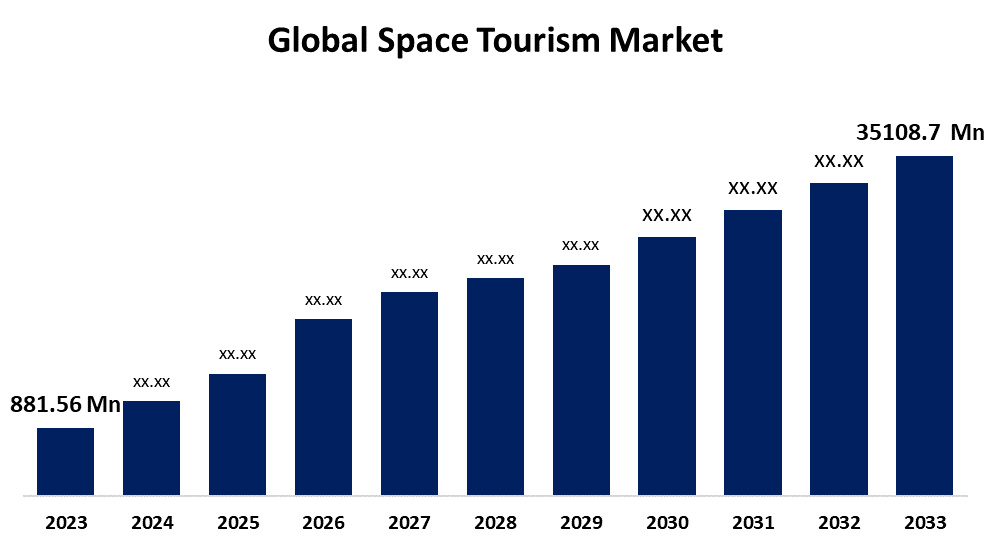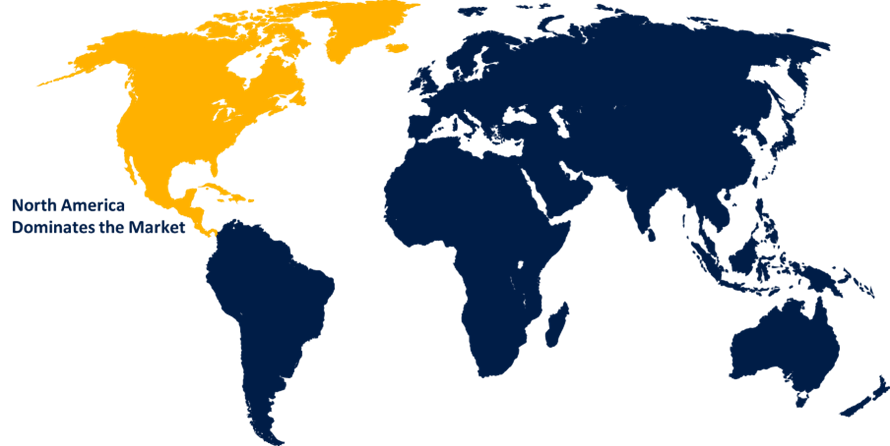Global Space Tourism Market Size, Share, and COVID-19 Impact Analysis, By Type (Orbital, Sub-orbital), By End User (Government, Commercial), and By Region (North America, Europe, Asia-Pacific, Latin America, Middle East, and Africa), Analysis and Forecast 2023 - 2033
Industry: Aerospace & DefenseGlobal Space Tourism Market Insights Forecasts to 2033
- The Global Space Tourism Market Size was Valued at USD 881.56 Million in 2023
- The Market Size is Growing at a CAGR of 44.55% from 2023 to 2033
- The Worldwide Space Tourism Market Size is Expected to Reach USD 35108.7 Million by 2033
- Europe is Expected to Grow the fastest during the forecast period.

Get more details on this report -
The Space Tourism Market Size is Anticipated to Exceed USD 35108.7 Million by 2033, Growing at a CAGR of 44.55% from 2023 to 2033.
Market Overview
The concept of "space tourism" describes going into space for fun, relaxation, or adventure. The chance to travel to space, previously only available to astronauts and scientists, is now available to the general public thanks to this growing space business sector. The market for space tourism is slowly expanding due to technological developments and rising demand from wealthy consumers who are prepared to pay for this exceptional experience. Because of its ability to provide a completely fresh and distinct experience that is not possible on Earth, space tourism is growing in popularity. Conventional luxury vacations on Earth could provide leisure and amusement, but space travel delivers an unforgettable experience that might alter one's viewpoint and comprehension of the universe. Travelling into space offers the chance to observe Earth's beauty from an entirely new angle. It enables one to recognize the fragility and interdependence of all species on Earth and to view the Earth as a whole. Suborbital and orbital travel are encompassed by this market, and leading providers of commercial space travel services are SpaceX, Virgin Galactic, and Blue Origin. At the moment, suborbital flights which provide a glimpse of Earth from orbit and a few minutes of weightlessness are more accessible and less expensive than orbital flights, which require spending longer periods in space.
Report Coverage
This research report categorizes the market for the space tourism market based on various segments and regions forecasts revenue growth and analyzes trends in each submarket. The report analyses the key growth drivers, opportunities, and challenges influencing the space tourism market. Recent market developments and competitive strategies such as expansion, product launch, and development, partnership, merger, and acquisition have been included to draw the competitive landscape in the market. The report strategically identifies and profiles the key market players and analyses their core competencies in each sub-segment of the space tourism market.
Global Space Tourism Market Report Coverage
| Report Coverage | Details |
|---|---|
| Base Year: | 2023 |
| Market Size in 2023: | USD 881.56 Million |
| Forecast Period: | 2023-2033 |
| Forecast Period CAGR 2023-2033 : | 44.55% |
| 2033 Value Projection: | USD 35108.7 Million |
| Historical Data for: | 2019-2022 |
| No. of Pages: | 213 |
| Tables, Charts & Figures: | 110 |
| Segments covered: | By Type, By End User, By Region |
| Companies covered:: | SpaceX, Blue Origin, Orion Span, Boeing, Zero-G, Space Adventure, Zero 2 Infinity, World View, Space Perspective, Nanoracks, Axiom, and Others |
| Pitfalls & Challenges: | Covid-19 Empact, Challenges, Growth, Analysis. |
Get more details on this report -
Driving Factors
Encouraging regulatory changes are making celestial travel safer and easier to obtain, protecting passenger safety and fostering industry expansion. The growing astronomical tourism industry is expected to have a significant economic impact, leading to the creation of jobs and advancements in allied industries including tourism, hospitality, and aerospace. It is anticipated that in the forecast period, astronomical tourism will become more widely available to the general public due to developments in technology and regulations as well as the ongoing interest of wealthy individuals. This rapidly growing sector has the potential to revolutionize travel experiences and create new opportunities for both business and pleasure travel.
Restraining Factors
Junk from spacecraft launches can remain in orbit for several years, and the quantity of junk produced rises with the number of space launches. Even small debris can result in damage and cause issues for other missions.
Market Segmentation
The space tourism market share is classified into type and end user.
- The sub-orbital segment is expected to hold the largest share of the space tourism market during the forecast period.
Based on the type, the space tourism market is categorized into orbital, and sub-orbital. Among these, the sub-orbital segment is expected to hold the largest share of the space tourism market during the forecast period. Through suborbital tourism, people can visit the edge of space without going into orbit, feel weightless, and observe space without ever leaving Earth's orbit. The vehicle's speed distinguishes between orbital and suborbital flights; suborbital flights go at slower speeds and do not reach orbit. These flights reach a certain altitude and then, as soon as the engines cut, return to Earth. Because it's cheaper to manufacture suborbital flights than to launch them, companies are concentrating more on them.
- The commercial segment is expected to grow at the fastest CAGR during the forecast period.
Based on the end user, the space tourism market is categorized into government, and commercial. Among these, the commercial segment is expected to grow at the fastest CAGR during the forecast period. The commercial space tourism sector is expanding rapidly, and advancements in this area are opening up the possibility of space travel. Building essential infrastructure, such spaceships and space terminals, is creating a solid foundation for the industry's growth. More safe and dependable space travel choices are being produced as a result of competition among the major companies in the space tourism sector. New avenues for education and research in space are being made possible by collaborations between tourism companies and educational institutions.
Regional Segment Analysis of the Global Space Tourism Market
- North America (U.S., Canada, Mexico)
- Europe (Germany, France, U.K., Italy, Spain, Rest of Europe)
- Asia-Pacific (China, Japan, India, Rest of APAC)
- South America (Brazil and the Rest of South America)
- The Middle East and Africa (UAE, South Africa, Rest of MEA)
North America is projected to hold the largest share of the space tourism market over the forecast period.

Get more details on this report -
North America is projected to hold the largest share of the space tourism market over the forecast period. With its advanced infrastructure and large base of research and development, the region is expected to provide the most revenue to the worldwide market throughout the forecast period. The quick uptake of contemporary technology is facilitated by this sophisticated infrastructure. Further propelling market expansion has been the substantial presence of small and medium-sized businesses in North America. Further supporting the market's expected expansion in the United States are technological advancements in space travel, including as reusable rockets and spacecraft, which have reduced costs and improved accessibility to space tourism experiences.
Europe is Expected to Grow at the fastest CAGR growth of the space tourism market during the forecast period. Space tourism efforts are receiving more and more backing from European governments and organizations such as the European Space Agency (ESA). However, the space tourism business has gained speed due to the engagement of private enterprises such as Virgin Galactic, Blue Origin, and SpaceX. By investing in the development of vehicles and infrastructure for space tourism, these corporations are increasing the viability and appeal of space travel to a wider range of people.
Competitive Analysis:
The report offers the appropriate analysis of the key organizations/companies involved within the space tourism market along with a comparative evaluation primarily based on their product offering, business overviews, geographic presence, enterprise strategies, segment market share, and SWOT analysis. The report also provides an elaborative analysis focusing on the current news and developments of the companies, which includes product development, innovations, joint ventures, partnerships, mergers & acquisitions, strategic alliances, and others. This allows for the evaluation of the overall competition within the market.
List of Key Companies
- SpaceX
- Blue Origin
- Orion Span
- Boeing
- Zero-G
- Space Adventure
- Zero 2 Infinity
- World View
- Space Perspective
- Nanoracks
- Axiom
- Others
Key Market Developments
- In March 2024, validating flight systems and in-space processing, Blue Origin showcased the operational capabilities of its Blue Ring spacecraft on the Defense Innovation Unit's DarkSky-1 mission. The goal of this public-private partnership is to improve Blue Ring's multi-orbit accessibility in order to facilitate the idea of more space exploration by humans. The mission's exact launch time was unknown, although it took place on the upper stage of an unidentified National Security Space Launch provider.
- In October 2023, Blue Origin introduced Blue Ring, a spacecraft platform that provides commercial and government customers with full in-space logistics and delivery capabilities. Blue Ring offers logistics, cloud computing, payload hosting, transport, refueling, and data transmission services in space. It operates from medium Earth orbit to the Cislunar area. Blue Ring's payload capacity exceeds 3,000 kg, which can result in cost savings and ease of mission planning for a wide range of customers.
Key Target Audience
- Market Players
- Investors
- End-users
- Government Authorities
- Consulting And Research Firm
- Venture capitalists
- Value-Added Resellers (VARs)
Market Segment
This study forecasts revenue at global, regional, and country levels from 2020 to 2033. Spherical Insights has segmented the global space tourism market based on the below-mentioned segments:
Global Space Tourism Market, By Type
- Orbital
- Sub-orbital
Global Space Tourism Market, By End User
- Government
- Commercial
Global Space Tourism Market, By Regional
- North America
- US
- Canada
- Mexico
- Europe
- Germany
- UK
- France
- Italy
- Spain
- Russia
- Rest of Europe
- Asia Pacific
- China
- Japan
- India
- South Korea
- Australia
- Rest of Asia Pacific
- South America
- Brazil
- Argentina
- Rest of South America
- Middle East & Africa
- UAE
- Saudi Arabia
- Qatar
- South Africa
- Rest of the Middle East & Africa
Frequently Asked Questions (FAQ)
-
1. What is the CAGR of the Global space tourism market over the forecast period?The Global Space Tourism Market Size is Expected to Grow from USD 881.56 Million in 2023 to USD 35108.7 Million by 2033, at a CAGR of 44.55% during the forecast period 2023-2033.
-
2. Which region is Expected to hold the highest share in the global space tourism market?North America is projected to hold the largest share of the space tourism market over the forecast period.
-
3. Who are the top key players in the space tourism market?SpaceX, Blue Origin, Orion Span, Boeing, Zero-G, Space Adventure, Zero 2 Infinity, World View, Space Perspective, Nanoracks, Axiom, and Others.
Need help to buy this report?